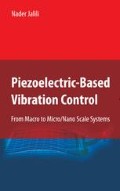Abstract
This chapter provides an introduction to what is covered in this book. A general definition of smart structures along with a list of few select active materials as the building blocks of smart structures is given first. The concept of vibration control and its classifications are presented next, followed by an overview of different modeling and control strategies for both discrete and continuous dynamical systems.
Access this chapter
Tax calculation will be finalised at checkout
Purchases are for personal use only
Notes
- 1.
The words “structures” and “systems” are used interchangeably for “smart structures” in the literature. We must, however, note that “structures” typically refer to particular elements or mechanical components, while “systems” are more general forms and include a collection of components that may be defined by real or imaginary boundaries. It is worthy to note that all structures are systems.
- 2.
There is an increasing interest within the smart structures community in replacing the traditionally used word “smart” with “intelligent”.
- 3.
Most parts of this section may have come directly from our book chapter on the subject matter (Jalili and Esmailzadeh 2005).
References
Bayo E (1987) A finite-element approach to control the end-point motion of a single-link flexible robot. J Robotic Sys 4:63–75
Benaroya H (1998) Mechanical vibration: Analysis, uncertainties, and control. Prentice Hall, Inc., NJ
Culshaw (1996) Smart structures and materials, Artech House
Dadfarnia M, Jalili N, Liu Z, Dawson DM (2004a) An observer-based piezoelectric control of flexible Cartesian robot arms: theory and experiment. Control Eng Pract 12:1041–1053
de Querioz MS, Dawson DM, Nagarkatti SP, Zhang F (2000) Lyapunov-based control of mechanical systems, Birkhauser, Boston MA
Esmailzadeh E, Jalili N (1998a) Optimum design of vibration absorbers for structurally damped Timoshenko beams. ASME J Vib Acous 120(4):833–841
Ge SS, Lee TH, Zhu G (1997) A nonlinear feedback controller for a single-link flexible manipulator based on a finite element method. J Robotic Syst 14(3):165–178
Inman DJ (2007) Engineering vibration, 3rd edn. Prentice Hall Inc
Jalili N (2000) A new perspective for semi-automated structural vibration control. J Sound Vib 238(3):481–494
Jalili N, Olgac N (2000a) Identification and re-tuning of optimum delayed feedback vibration absorber. AIAA J Guid Control Dyn 23(6):961–970
Jalili N, Esmailzadeh E (2001) Optimum active vehicle suspensions with actuator time delay. ASME J Dyn Syst Measur Control 123:54–61
Jalili N (2001a) An infinite dimensional distributed base controller for regulation of flexible robot arms. ASME J Dyn Sys, Measur Cont 123(4):712–719
Jalili N, Esmailzadeh E (2002) Adaptive-passive structural vibration attenuation using distributed absorbers. J Multi-body Dyn 216:223–235
Jalili N, Esmailzadeh E (2003) A nonlinear double-winged adaptive neutralizer for optimum structural vibration suppression. J Comm Nonlinear Sci Num Simul 8(2):113–134
Jalili N, Esmailzadeh E (2005) Vibration control, chapter 23 of the vibration and shock handbook, CRC Press LLC, ISBN/ISSN: 0-84931580, 23:1047–1092
Lee-Glauser GJ, Ahmadi G, Horta LG (1997) Integrated passive/active vibration absorber for multistory buildings. ASCE J of Struc Eng 123(4):499–504
Leo DJ (2007) Smart material systems: analysis, design and control. Wiley, New York
Margolis D (1998) Retrofitting active control into passive vibration isolation systems. ASME J Vib Acoust 120:104110
Nayfeh AH, Mook DT (1979) Nonlinear Oscillations, Wiley, New Jersey
Nayfeh AH, Pai PF (2004) Linear and nonlinear structural mechanics. Wiley, Hoboken, New Jersey
Olgac N, Jalili N (1998) Modal analysis of flexible beams with delayed-resonator vibration absorber: Theory and experiments. J Sound Vib 218(2):307–331
Puksand H (1975) Optimum conditions for dynamic vibration absorbers for variable speed systems with rotating and reciprocating unbalance. Int J Mech Eng Educ 3:145–152
Ramaratnam A, Jalili N (2006a) A switched stiffness approach for structural vibration control: Theory and real-time implementation. J Sound Vib 291(1–2):258–274
Smith RC (2005) Smart material systems: Model development, Society for Industrial and Applied Mathematics, Philadelphia
Soong TT, Constantinou MC (1994) Passive and active structural control in civil engineering, Springer, Wien and New York NY
Sun JQ, Jolly MR, Norris MA (1995) Passive, adaptive, and active tuned vibration absorbers – A survey. ASME Trans, Special 50th Anniversary, Design Issue. 117:234–242
Tzou HS, Lee HJ, Arnold SM (2004) Smart materials, precision sensors/actuators, smart structures, and structronic systems. Mech of Adv Mat Struc 11:367–393
Yuh J (1987) Application of discrete-time model reference adaptive control to a flexible single-link robot. J Robotic Sys 4:621–630
Author information
Authors and Affiliations
Corresponding author
Rights and permissions
Copyright information
© 2010 Springer Science+Business Media, LLC
About this chapter
Cite this chapter
Jalili, N. (2010). Introduction. In: Piezoelectric-Based Vibration Control. Springer, Boston, MA. https://doi.org/10.1007/978-1-4419-0070-8_1
Download citation
DOI: https://doi.org/10.1007/978-1-4419-0070-8_1
Published:
Publisher Name: Springer, Boston, MA
Print ISBN: 978-1-4419-0069-2
Online ISBN: 978-1-4419-0070-8
eBook Packages: EngineeringEngineering (R0)

